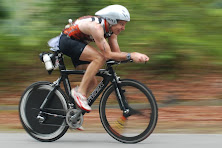Following hot on the heels its classics-themed Domane endurance frame release, Trek showed a brand new, wholly redesigned Madone at the first road stage of the Critérium du Dauphiné on Monday. Most of the RadioShack-Nissan team started the day aboard the new bike, the Madone 7, including likely Tour de France starters Andy Schleck, Yaroslav Popovich and Haimar Zubeldia.
With an official launch slated for later this month, Trek was tight-lipped about the frame itself, and wouldn’t allow VeloNews.com to take a model out of the team’s start-area paddock. Nonetheless, the wholesale redesign includes a number of visually obvious features.
Nods to aerodynamics
While the new Madone isn’t an aero road frame of the traditional Cervélo-esque, narrow tube-profile sort, it does contain a number of visible design features that look to be intended to cut down on aerodynamic drag.
First and foremost is the use of Kamm tail tube shapes throughout the frame. The tubes are significantly wider than those used on Trek’s Speed Concept time trial frame, which also uses Kamm tails, but the theory remains the same: cut the back end off of an aero profile, taper the back edges correctly, and you end up with an aero shape while maintaining tube width (and thus stiffness). The trailing edge of the Madone 7’s wide downtube and head tube are lopped off, as are the trailing sides of the seat stays and seat tube, which curves a bit with the wheel as it enters the bottom bracket.
If there was any doubt as to the aero intentions of these tube shapes (which don’t look particularly aero, much like the Scott Foil tubes), it is erased by the large “KammTail Virtual Foil” logo on the downtube.
The Kamm-tailed fork is set wide, away from the spokes, and the fork blades themselves look rather small relative to the bulky head tube. The head tube juts out in front of the fork crown, neatly integrating the front brake, which Trek team liason Jordan Roessingh said is a Shimano-built brake “of the same generation as the stuff Sky is running.” That means it’s the integrated aero brake announced last week as part of the new Shimano Dura-Ace 9000 component group.
The rear brake has been moved from the seat stays to under the bottom bracket, like many time trial bikes. Again, Trek is using the new Dura-Ace 9000 integrated brake model. The internal cabling exits just in front the bottom bracket shell, with about four inches of housing exposed before entering the brake itself. It’s all extremely tidy, and a quick glance shows all the necessary bolts are easy to access, which should make wrenching a bit easier.
This isn’t the first time brakes have been integrated into a standard road frame — Ridley’s NOAH Fast is still the finest example, technically, with its carbon brake arms part of the frame mold itself — but it is a harbinger of a growing trend. As with time trial frames, which rarely had integrated brakes just a few years ago but now rarely launch without them, we expect to see increasing use of under-BB brake mounts and increased integration of front and rear brakes into frames and forks.
The industry now appears to be moving towards this integration as a whole, wich is a requirement since bikes need to be designed with these brakes in mind from the start. They use a two-bolt mount rather than the traditional single bolt; the Madone 7, at least as far as we could see, will only be compatible with these two-bolt front brakes, unless Trek has hidden a traditional single-bolt caliper mount in there. That makes the debut of Shimano’s 9000-series two-bolt integrated brake pivotal for the continuation of this trend. Though companies like TRP were the pioneers, and have offered similar models for some time (which are widely used on TT bikes), the backing of the biggest name in the sport and its relationships with frame manufacturers will likely result in a bloom in road frame brake integration over the next few years.
The more standard aero design cues are present as well. As with the Madone 6, all cables and housing are run internally. The Di2 cables on the RadioShack bikes exited the back end of the right chainstay, as they did before. The Di2 exit port for the front derailleur has been moved to the back of the seat tube to better integrate with the new, rear-facing plug on Dura-Ace Di2 9070. Both brake and derailleur cables enter at the headtube/downtube junction on the left side of the frame, as with the Domane.
The trend continues towards a balance between more traditional, wide tube shapes with some concessions made for aerodynamics, rather than a wholesale jump onto the anti-drag wagon. As anyone who read the May issue of Velo Magazine, and the aero road frame review within, will know, we dig this compromise, appreciating the free speed while treasuring true race-frame ride quality. Check back as the Tour de France approaches, when we should have an opportunity to get on the Madone 7 and find out if it checks all those boxes.
Simon says: -
I'm not sure how pretty this bike is but it's Kamm Tail all the way and quite radical. I must say I'm surprised they didn't go the whole hog with the front brakes built into the forks like they did with the Speed Concept and there's still an awful lot of cable and wires floating around at the front which surely can be buried internally somehow. Looks exciting and different though so we shall see. Check out this article with 25 pictures here.



1 comment:
lol @ The Captain! haha
I want a roadie just to get some rides in on a different setup than the Tri position. Considering a cross bike to do some cyclocross races and can put roadie tires to use as road bike
Post a Comment